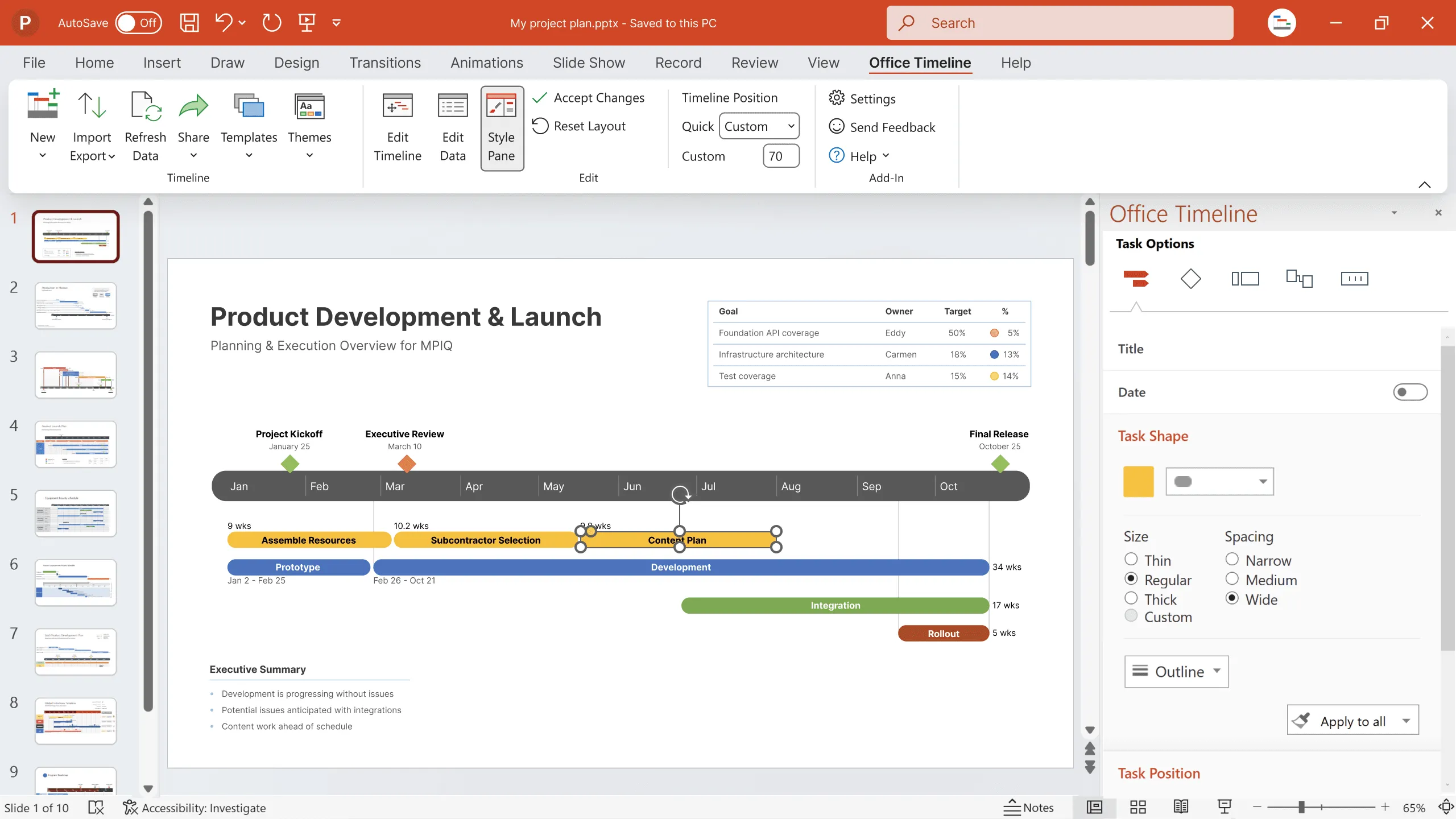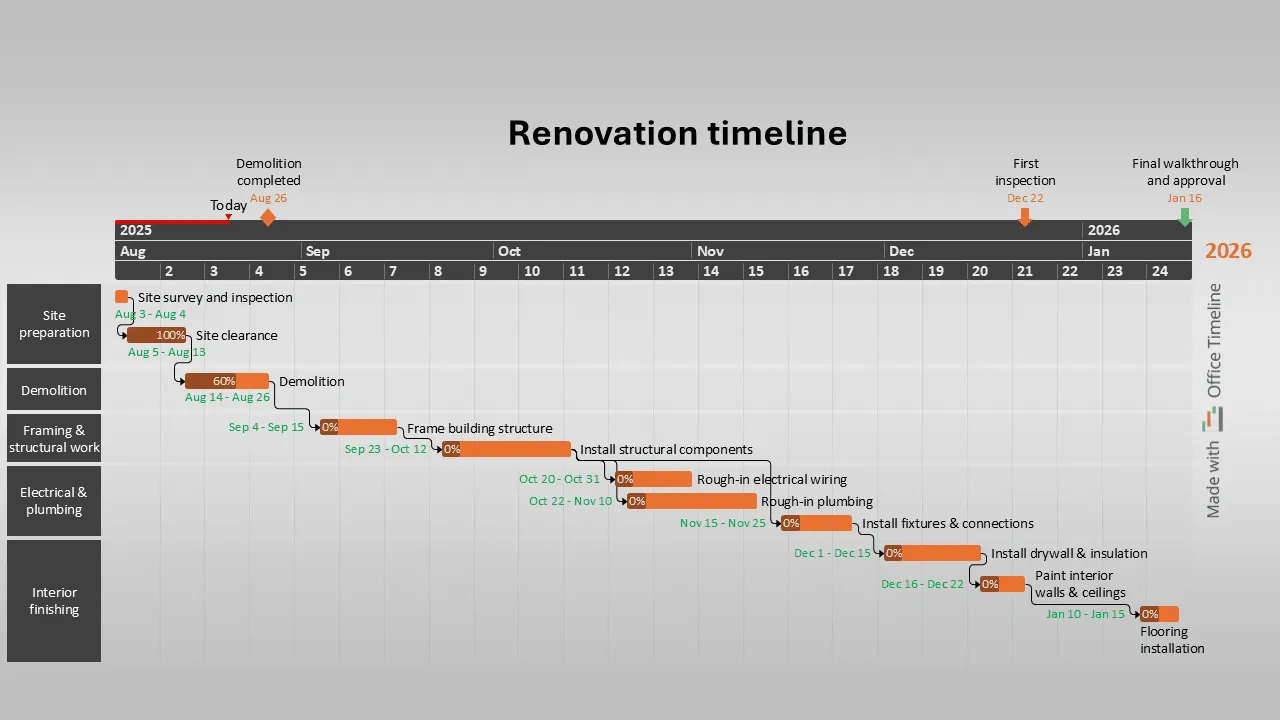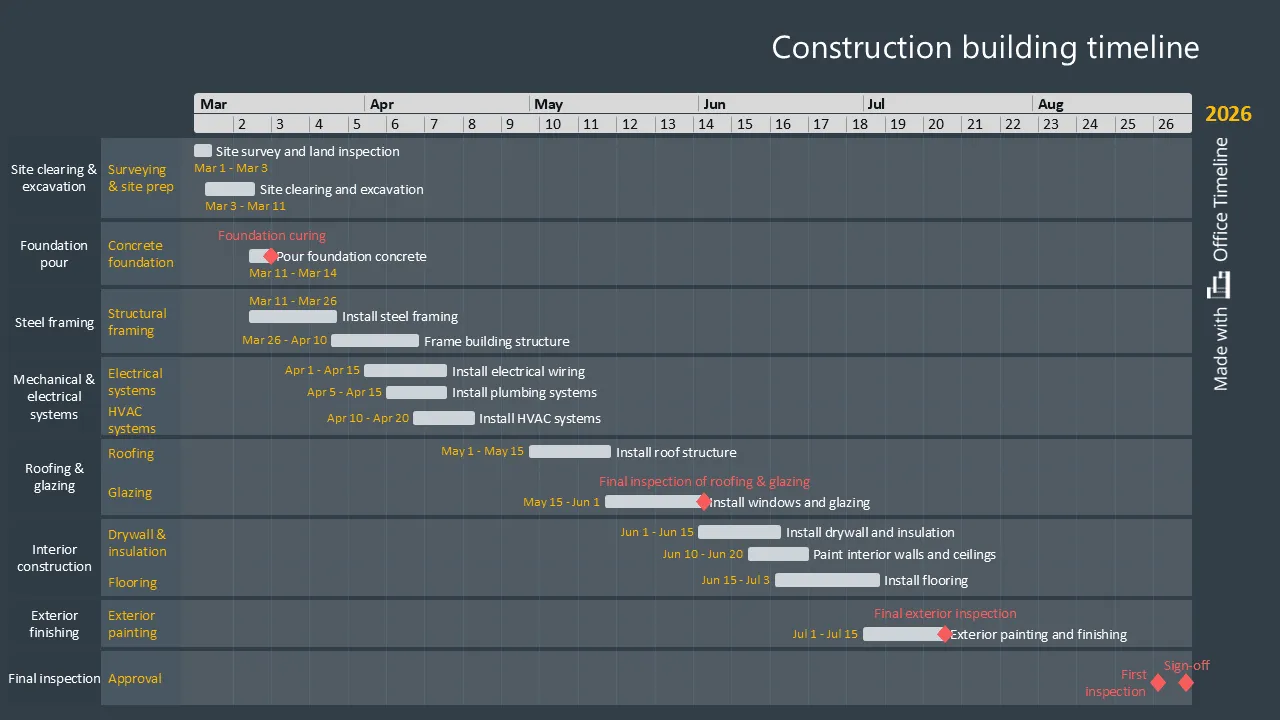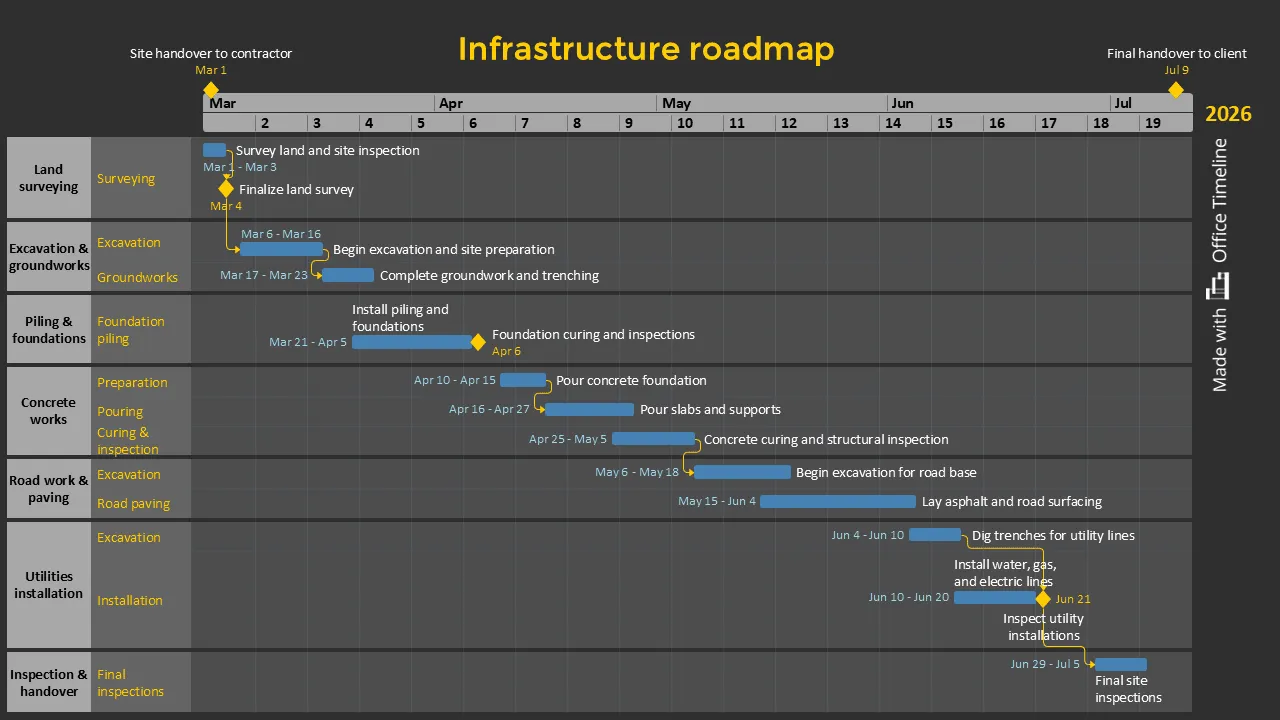Why construction projects go over budget (+ how to fix it)
Discover the budget killers in construction projects and learn how proper timelines can save thousands in standby time, rework, and coordination costs.

Here's a question that probably keeps you up at night: Why do construction projects always end up costing more than planned? You bid the job carefully, added your margins, accounted for the usual suspects, and somehow, you're still explaining to clients why they owe you another $15,000.
The ugly truth? It's rarely the big, obvious stuff that kills your budget. It's the death by a thousand cuts: crews sitting idle because materials are late, rework because trades stepped on each other, overtime because everything's behind schedule, and change orders that could have been avoided with better planning.
But here's what most contractors miss: 90% of budget overruns trace back to poor scheduling and coordination. That foundation crew charging you standby time? That's a scheduling problem. The electrical contractor who had to come back three times because other trades weren't done? Coordination failure. The client who's now asking for "small changes" that require tearing out work? That's what happens when timelines aren't clear from day one.
The good news? This is completely fixable. And it doesn't require fancy software or an MBA, just a solid project timeline that actually works.
The hidden budget killers nobody talks about
You know what's expensive? Standby time. Rework. Rush deliveries. Overtime. Change orders that could have been caught early. These aren't inevitable misfortunes, they're predictable outcomes of poor project coordination.
Take standby time alone. Your concrete crew shows up, but the forms aren't ready because the framing crew hit a snag yesterday that nobody saw coming. Now you're paying $800/day for a crew to sit in their trucks playing on their phones. Do this three times on a project, and you've just blown through your entire contingency fund.
Or how about this classic: The plumber rough-ins the bathroom, then the electrician needs to run conduit through the same wall space. Guess who's tearing out freshly installed pipes? That's not just material cost, that's labor, disposal, schedule delays, and one very unhappy plumber who's going to remember this next time you call.
And let's talk about change orders. Sure, some are legitimate client changes. But how many happen because nobody realized that the “minor electrical upgrade” the client mentioned in week two would require a complete panel replacement that should have been ordered a month ago?
All of this stuff cascades. One delay creates another delay, which creates overtime, which creates rushed work, which creates mistakes, which creates more delays. Before you know it, your 10% margin has evaporated and you're working for free.
Three projects, three budget saves: How timelines protect your margins
Here's the proof that proper planning pays off. These three projects show how solid timelines can turn potential budget disasters into profitable wins. Each one represents a different type of construction challenge, and each one demonstrates how the right approach can save you thousands.
The timeline examples you'll see below were created with Office Timeline, a simple PowerPoint add-in that makes professional project schedules without the complexity of traditional project management software. Want to use these exact templates for your own projects? You can download any of them for free. Just grab the Office Timeline free trial first so you can customize them to fit your specific needs.
Now let's dive into how these timelines can save real money on real projects.
Use case 1: The renovation nightmare that wasn't
Renovations are where good project managers go to test their limits. You never know what's hiding behind those walls until you start swinging hammers. Take, for instance, a commercial renovation that should have been a straightforward update of an old office space for a tech startup.
The timeline broke everything down: site prep, demo, structural work, MEP (mechanical, electrical, plumbing), and finish work. Simple enough, right?
Week two, demo crew hits a load-bearing wall that wasn't on the original plans. In the old days, this would have meant chaos - crews scrambling, schedules blown, everyone pointing fingers. But because we had a solid timeline with built-in buffers and clear dependencies mapped out, we knew exactly how this delay would ripple through the project.
The framing crew got moved to another job for three days while a structural engineer was brought in. The electrical rough-in got pushed back by a week, which actually worked out because the electrician had another project wrapping up. Instead of a disaster, it became a minor hiccup.
The lesson? When your timeline shows dependencies clearly, you avoid expensive surprises. No standby time, no emergency structural engineers at premium rates, no crews sitting around burning your labor budget. That three-day delay could have cost $8,000 in standby and overtime. Instead, it cost zero because there was a plan for exactly this scenario.
Use case 2: Commercial build coordination
Commercial projects are like conducting an orchestra where half the musicians showed up drunk and the other half are playing different songs. You've got foundation crews, steel erectors, mechanical contractors, roofers, and interior teams, all with their own schedules, their own priorities, and their own opinions about who should go first.
Take a recent 50,000 sq ft warehouse project. Six-month timeline, tight budget, and a client who needed to be operational by Black Friday (because of course they did).
The visual timeline became sort of a Bible for the construction team. Site clearing and excavation had to wrap before foundation crews could even think about showing up. Steel framing couldn't start until concrete reached full strength, and everyone knew it. When the mechanical contractor tried to push their rough-in schedule up by two weeks, one glance at the timeline showed exactly why that wasn't happening.
The magic moment came when the roofing contractor called to say their crew was available a week early due to another job cancellation. Instead of panicking about whether we could accommodate them, we pulled up the timeline and saw that steel framing was actually ahead of schedule. Boom - we moved up the roofing and actually gained time on the project.
The result? The project was delivered two weeks early, under budget, and saved approximately $12,000 in potential coordination conflicts and standby time. More importantly, every subcontractor wants to work with this company again because it made their jobs easier.
Use case 3: Infrastructure. When "big picture" really means big picture
Infrastructure projects are beasts. Roads, bridges, utility work. These are more than construction projects, they are community events. You've got environmental concerns, traffic management, utility coordination, and about fifteen different government agencies all wanting their piece of the action.
Take a recent municipal road reconstruction project that included new water mains, storm sewers, and complete street rebuilding. Two-year timeline, multiple phases, and the city breathing down the contractor's neck because local businesses were losing money during construction. The project timeline became the communication tool with everyone: city officials, utility companies, local businesses, even residents. When the water department wanted to know when they could start their tie-ins, the project manager didn't have to guess or make promises they couldn't keep. It was right there on the timeline: utilities installation starts week 15, after excavation and underground infrastructure are complete.
When spring flooding delayed excavation by ten days, the timeline showed exactly which subsequent phases would be affected and by how much. The team could make informed decisions about bringing in extra crews, adjusting work hours, or resequencing tasks to minimize delays.
The bottom line? Clear project timelines prevented an estimated $25,000 in weather-related delays, emergency overtime, and coordination conflicts. When city officials asked about impacts on local businesses, the contractor could show them exactly when disruptions would occur and for how long. That transparency actually led to additional work with the municipality.
The real ROI: what proper planning actually saves you
Sure, timelines make you look like you know what you're doing. But the real payoff? They stop you from bleeding money. Here's what happens when you get this right:
- You eliminate standby time. No more crews sitting around waiting for the previous trade to finish. When everyone knows exactly when they're needed, they show up ready to work - not ready to wait.
- You reduce rework by 70%. When trades know exactly what's happening before and after their work, conflicts disappear. The plumber doesn't install pipes where the electrician needs to run conduit.
- Your material costs become predictable. No more rush deliveries at premium prices because nobody realized the steel needed to be on site three days earlier.
- Change orders become rare. When clients can see exactly how their “small changes” impact the timeline and budget, they make better decisions upfront.
- Your subs give you better pricing. Contractors charge less when they know you have your act together. They also prioritize your jobs because working with organized GCs makes their lives easier.
- You can actually plan cash flow. Instead of guessing when payments will come in, you know exactly when milestones will be hit and invoices can go out.
Start simple, save big
Here's the best part: you don't need to become a project management guru overnight to start protecting your margins. The best timeline tool is the one you'll actually use consistently, and that doesn't mean the most expensive one.
There are contractors who swear by hand-drawn Gantt charts taped to the job trailer wall. If your crew understands it and follows it, it works. But let's be honest, clients today expect something a bit more polished when you're walking them through a $500K project.
That's where something like Office Timeline comes in handy. It's not trying to be everything to everyone. It is just a straightforward way to create professional-looking timelines that you can actually update without a computer science degree. You can build a clear project roadmap in PowerPoint (which most of us already know), and when the client asks “when will the electrical be done?”, you're not scrambling through sticky notes on your clipboard.
The real magic isn't in the tool, though, it's in the thinking. Whether you're using fancy software or a whiteboard, you need to break your project into logical phases, identify what depends on what, build in realistic buffers, and communicate the plan clearly to everyone involved.
Start with your next project. Before you mobilize, sit down and map out every major phase. Mark the dependencies: what can't start until what else is finished. Identify your critical path (the sequence of tasks that determines your overall project duration). Build in buffer time for the inevitable surprises.
Then share it with everyone. Your foremen, your subs, even your clients. When everyone can see the plan, everyone can help protect it. And when something does go sideways (because it will), you can show exactly how it affects the rest of the project instead of just saying “it'll cause delays.”
Ready to see how much time you can save on your next project timeline? Office Timeline offers a 14-day free trial that lets you build professional project schedules without the learning curve. Take one of your upcoming projects and map it out properly. You might be surprised how many potential budget killers you spot before they happen. The trial's free, and if it saves you just one day of standby time, it's already paid for itself.
Frequently asked questions about construction project timelines
Got questions about implementing timelines on your construction projects? Here are the most common concerns we hear from contractors, along with straight answers that actually help.
Detailed enough to prevent conflicts, simple enough that everyone understands it. Break down major phases (foundation, framing, MEP, finishing) but don't micromanage every single task. If a phase takes more than 2-3 weeks, consider splitting it into sub-phases.
First, assess the impact: does this delay affect your critical path? If not, you might have natural buffer time. If yes, look at options: add crews, adjust work hours, or resequence non-dependent tasks. The key is communicating changes to everyone immediately. Do not assume you can catch up later.
Show them exactly how their change impacts the timeline and budget. A visual timeline makes this conversation much easier. You can point to specific phases that will be affected and give them a clear choice: accept the delay and cost, or stick with the original plan.
For renovation work, add 15-20% buffer time.
New construction typically needs 10-15%.
Infrastructure projects often need 20-25% due to weather and permit variables.
Tip: Don't tell clients about the buffer, just build it into your realistic completion dates.
The one you can use without headaches. Office Timeline works well because it integrates with PowerPoint, which most people already know. Microsoft Project is powerful but overkill for most construction projects. And even a well-organized Excel spreadsheet beats no timeline at all.
Make it visible (print it large, post it in the job trailer), keep it updated, and reference it in every meeting. When crew members see you consistently using and updating the timeline, they start taking it seriously. Also, explain how staying on schedule affects their next job; most crews want steady work.
Project management tips and tricks
Tagged With:
Examples by industryTurn project data into professional timelines
Get the advanced features of Office Timeline free for 14 days.





